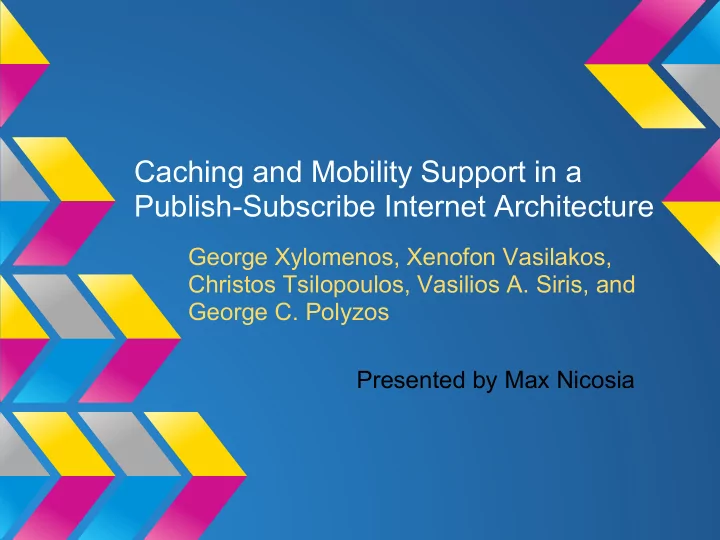

Caching and Mobility Support in a Publish-Subscribe Internet Architecture George Xylomenos, Xenofon Vasilakos, Christos Tsilopoulos, Vasilios A. Siris, and George C. Polyzos Presented by Max Nicosia
Motivation ● Need for Mobility ● Change in usage model ○ From sharing Resources -> Info (regardless of end-point hosting it) PSI claims: ● Scaling not affected by addressing or routing assumptions ● Supports native multicasting ● Asynchronous nature and caching help with MN handoff
Architecture Overview Naming: ● Scope Identifier (SID) ● Rendezvous Identifier (RID) Network Primitives: ● Publish ● Subscribe
Architecture Overview (cont) Functions (3): ● Rendezvous ● Topology Management ● Forwarding
Example Retrieval Steps: 1. Producer publishes item 2. Consumer subscribes 3. Subscription is propagated to the Rendezvous Function 4. Topology Manager constructs forwarding path -> Forwarding Identifier (FID) and returns it to Publisher (notification) 5. Publisher starts transmission
Network Design 4 Types of Elements: 1. Hosts 2. Forwarding Nodes (FNs) 3. Rendezvous Nodes (RNs) 4. Topology Managers (TNs) Key Benefits (Hosts behind gateway RN): ● Increased security and privacy ● Reduced control overhead and rendezvous traffic
Forwarding ● Using LIPSIN ○ On-path links encoded in fixed size bit string (Bloom Filter) -> FID ○ Included in packet ● Packets can be delivered over multicast trees by adding tree links to the FID ○ No extra state in the network is required ● Topology Managers can enforce routing policies
RENE and Topology Management ● Made out of multiple RNs ○ Built from FNs and RNs talking to TMs ○ Link State Announcements (LSA) ● Topologies built used for intra-domain routing ● TMs send FIDs with paths
Transport ● RNs maintain list of subscribers (state) ● New subscribers are added to FID ● Documents (reliable delivery) ○ TMs compute bidirectional FIDs ● Push-based ● Pull-based
Caching and Replication ● On-path Caching ● Off-path Caching ● Content Replication
On-path Caching ● Requests can be served by FNs on the path ● Prevent feedback implosion of multicast errors ● Possible to use on the Internet at the Application layer ○ Requires proxy server for Browser
Off-path Caching ● Take advantage that any node can serve request ● RENE can decides to cache or not to cache info ● Additional overhead -> announce to local RENE ● Hard to achieve on the Internet as it needs coordination between various application-level caches
Content Replication ● Used to minimise inter-domain traffic and improve user experience ● Does not rely on DNS tricks like on the Internet ● Can also exploit off-path caching
Mobility and Caching ● Decoupling from Time and Space ● Re-issue subscriptions for missed data ○ RENE takes care of redirection to caches ● Micro-mobility: ○ Use off-path caches to support MNs -> requests forwarded after handoff to cache ○ Assigned based on topology or forecasting ● Macro-mobility: ○ Set caches in neighbouring networks (expensive)
Conclusions ● Information-centric architecture ● Individually identified items can be cached at Network Layer ● Asynchronous nature of PSI make it mobile-ready ● Constantly evolving architecture
Critique ● No performance analysis about the impact on the network on various conditions ○ Possibly not very applicable in many cases ● Privacy concerns about data being replicated without any control
Questions?
Recommend
More recommend